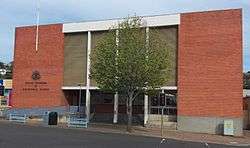Supreme Court of Tasmania
| Supreme Court of Tasmania | |
|---|---|
 | |
|
Supreme Court of Tasmania building, Hobart | |
| Established | 10 May 1824 |
| Location | Hobart |
| Coordinates | 42°53′10″S 147°19′46″E / 42.886048°S 147.329556°ECoordinates: 42°53′10″S 147°19′46″E / 42.886048°S 147.329556°E |
| Composition method | Vice-regal appointment unpon Premier's nomination, following advice of the Attorney General and the Executive Council. |
| Authorized by | Parliament of Tasmania via the Supreme Court Act 1959 (Tas) |
| Decisions are appealed to | High Court of Australia |
| Decisions are heard for appeals from | Magistrates' Court of Tasmania |
| Judge term length | mandatory retirement by age of 72 |
| Number of positions | 7 |
| Website | www.supremecourt.tas.gov.au |
| Chief Justice of Tasmania | |
| Currently | Alan Blow OAM |
| Since | 24 April 2008 |
.jpg)

The Supreme Court of Tasmania is the highest State court in the Australian State of Tasmania. In the Australian court hierarchy, the Supreme Court of Tasmania is in the middle level, with both an appellate jurisdiction over lower courts, and decisions made by Court to be heard on appeal by the High Court of Australia.
The ordinary sittings of the Court occur in Hobart, Launceston and Burnie in Tasmania. The Court's Appeal division sits only in Hobart.
History of the Court
The Supreme Court of Van Diemen's Land (as Tasmania was then known) was established by The Royal Letters Patent of 13 October 1823 and commenced activities on 10 May 1824.[1] The Court is the oldest Supreme Court in Australia and predates the Supreme Court of New South Wales, if only by a period of just ten days. The supreme courts of Tasmania and New South Wales were initiated through the New South Wales Act 1823, and this gave those courts jurisdiction over New Zealand.[2] Sir John Pedder, after whom Lake Pedder is named, was the first Chief Justice of the court.
The first counsel to appear before the Court was Joseph Tice Gellibrand, who was appointed Tasmania's first Attorney-General, and took his oaths on the first day of the new Court. The first case before the Court was the trial of William Tibbs, who was found guilty and sentenced for manslaughter, receiving 3 years transportation.[3]
Jurisdiction of the Court
It has unlimited jurisdiction within the state in civil matters and hears the most serious criminal matters. It is around the middle of the Australian court hierarchy. The Supreme Court consists of a Trial Division (also known as Original Jurisdiction) and an Appeal Division (or Appellate Jurisdiction).[4]
Appeals from the Appeal Division of the Court are to the High Court of Australia. It was previously possible to appeal decisions of the Court of Appeal or the Court of Criminal Appeal (both parts of the Appeal Division) to the British Privy Council, but this ceased in 1986 when the Parliament of Australia passed the Australia Act 1986, which barred all such appeals to the Privy Council from Australian courts.
Civil matters involving consent orders, or for disputes involving less than $50,000, are dealt with by the Magistrates Court except in exceptional circumstances.
The Court receives appeals from Magistrate Courts in Tasmania in both criminal and civil matters. Committal proceedings, which are used in criminal matters to establish whether there is sufficient evidence against an accused person to warrant the time and expense of a trial, were abolished in Tasmania in 2000 with the amendment of the Justices Act 1959 (Tas). The Justices Act 1959 now provides that where there has been a plea of not guilty by an accused, there must be an order committing them for trial in the Supreme Court.
Unlike some other Australian states, Tasmania does not have an intermediate court division between the Supreme Court and the Magistrates Courts (such as a "District Court" or a "County Court").[5]
Composition of the Court
The Supreme Court of Tasmania is composed of up to seven judges appointed by the Governor on the advice of the Executive Council, a body of senior ministers including the state Premier. The current bench of six judges of the Supreme Court of Tasmania in order of seniority (with dates of appointment to the bench) are:[6]
- Chief Justice Alan Blow, OAM (13 June 2000);
- Justice Shan Tennent (13 March 2005)
- Justice Helen Wood (9 November 2009)
- Justice Stephen Estcourt (8 April 2013)
- Justice Robert Pearce (11 June 2013)
- Justice Michael Brett (10 July 2016)
There is also one lesser judicial officer, called the Associate Judge (previously called the Master), with responsibility for largely procedural matters in civil and criminal proceedings, and for some work in assessing the damages (amounts claimable) in civil proceedings. The current Associate Judge of the Supreme Court of Tasmania is Mr Stephen Holt (appointed 6 September 1999).
See also
- Judiciary of Australia
- List of Judges of the Supreme Court of Tasmania
- List of Tasmanian Supreme Court cases
References
- ↑ Supreme Court History – Charter of Justice, Supreme Court of Tasmania
- ↑ Wilson, James Oakley (1985) [First published in 1913]. New Zealand Parliamentary Record, 1840–1984 (4th ed.). Wellington: V.R. Ward, Govt. Printer. p. 16. OCLC 154283103.
- ↑ R v Tibbs [1824] TASSupC 1 (24 May 1824), AustLII
- ↑ Supreme Court – Jurisdiction, Supreme Court of Tasmania
- ↑ Annual Report 2007–2008, page 23, Supreme Court of Tasmania
- ↑ Current Judges, Supreme Court of Tasmania
